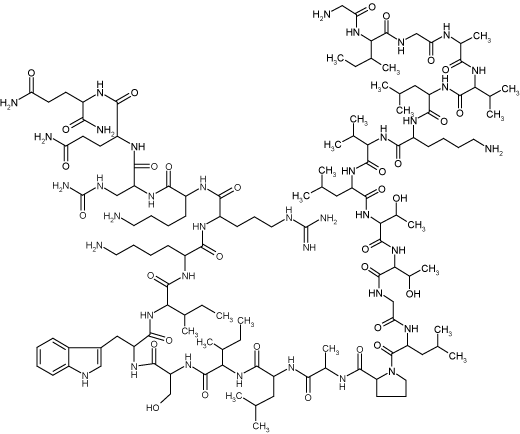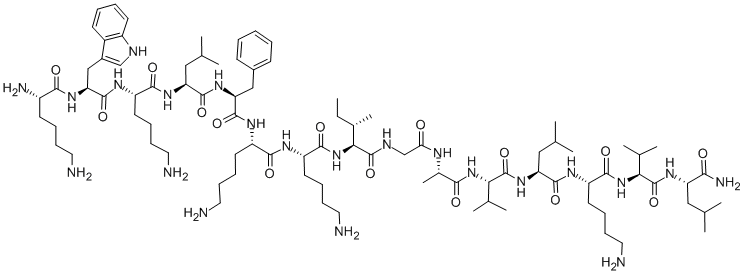Symbol Melittin InterPro IPR002116 SUPERFAMILY 2mlt Formula C131H229N39O31 | Pfam PF01372 SCOP 2mlt TCDB 1.C.18 | |
 | ||
Tpa on melittin
Melittin is the principal active component of apitoxin (bee venom) and is a powerful stimulator of phospholipase A2. Melittin is a peptide consisting of 26 amino acids with the sequence GIGAVLKVLTTGLPALISWIKRKRQQ.
Contents
- Tpa on melittin
- Melittin presentation 2
- Biological effects
- Potential therapeutic applications
- References

Melittin presentation 2
Biological effects

Melittin inhibits protein kinase C, Ca2+/calmodulin-dependent protein kinase II, myosin light chain kinase and Na+/K+-ATPase (synaptosomal membrane) and is a cell membrane lytic factor. Melittin is a small peptide with no disulfide bridge; the N-terminal part of the molecule is predominantly hydrophobic and the C-terminal part is hydrophilic and strongly basic.
Extensive work with melittin has shown that the venom has multiple effects, probably, as a result of its interaction with negatively charged phospholipids. It inhibits well known transport pumps such as the Na+-K+-ATPase and the H+-K+-ATPase. Melittin increases the permeability of cell membranes to ions, particularly Na+ and indirectly Ca2+, because of the Na+-Ca2+-exchange. This effect results in marked morphological and functional changes, particularly in excitable tissues such as cardiac myocytes. In some other tissues, e.g., cornea, not only Na+ but Cl− permeability is also increased by melittin. Similar effects to melittin on H+-K+-ATPase have been found with the synthetic amphipathic polypeptide Trp-3.

Melittin also exhibits potent anti-microbial activity. For example, melittin has been shown to exert "profound inhibitory effects" on Borrelia burgdorferi, the bacteria that causes lyme disease. Melittin has also been shown to kill the yeast Candida albicans and to suppress Mycoplasma hominis and Chlamydia trachomatis infections.
Potential therapeutic applications

At Washington University School of Medicine in St. Louis, very small nanobot "nanobee" devices are being developed to carefully deliver melittin (which is known to disrupt cell membranes, and thus, destroy cells) to tumor cells in animals. In February 2013, it was reported that nanoparticles carrying melittin were effective in destroying HIV by eroding the double-layer viral envelope surrounding the virus. Possible applications include a vaginal gel that would target HIV intrusion prior to infection and as an intravenous treatment of extant HIV infections.
It has been suggested that the regulation of S100B by melittin has potential for the treatment of epilepsy.

